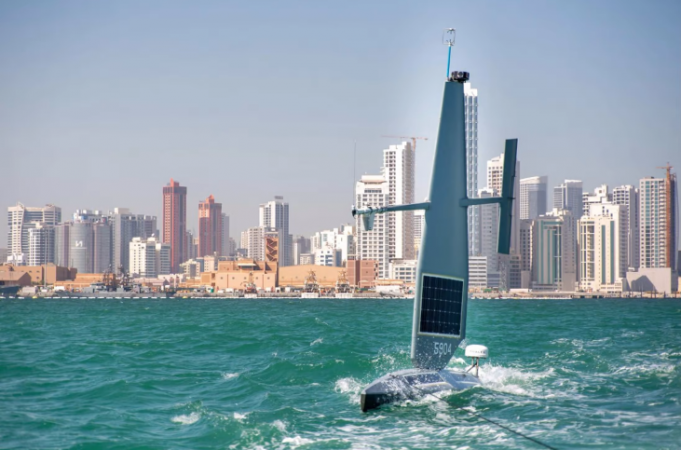
United States: In the Persian Gulf, the US Navy has accused Iran of attempting to seize one of its unmanned surface ships (USVs).
Iran's actions have been described by Vice Admiral Brad Cooper, commander of the US Naval Forces Central Command, as "vocal, unfair and inconsistent with the behavior of a professional maritime force".
According to the Navy, the Seldron Explorer was illegally taken from the international waters of the Persian Gulf. The Iranian naval support ship carrying the USV was informed that the drone was the property of the US government and was wanted back.
After hearing this the ship released the drone. "This incident once again demonstrates Iran's continued volatile and unprofessional activity in the Middle East," said General Michael Eric Kurilla, commander of US Central Command.
However, Iran may have justification for its actions.
A Celdrone Explorer is a USV that runs on wind and solar power and can collect data for up to a year.
A military version of the vessel has been dispatched as part of Operation Sentinel, a global task force created to "enhance the surveillance and security of major waterways in the Middle East".
According to Iranian news reports, the unmanned ship's "navigation system had failed" and posed a threat to global shipping. It is customary for sailors to eliminate such risks.
The Iranians clarified their concern about the danger of the device to the safety of navigation and returned it after learning that it belonged to the US Navy. Iran sees this as a professional contribution to the security of shipping, rather than an attempted piracy.
It is also possible that America's claims and actions were illegal. This partly depends on the exact location of the Seldron at the time Iran took control of it. The drone could be in Iran's Exclusive Economic Zone (EEZ), which covers a significant part of the Gulf.
Foreign users must "due respect" to the rights and obligations of the Coastal State when operating in the Coastal State's EEZ. This includes an obligation not to create a shipping risk.
The US could argue that the drone was conducting hydrographic or military surveys and as such, was exempt from that regime. However, UNCLOS states that "prior approval is required for the deployment and use of any type of scientific research installation or equipment in any area of the marine environment."
The US has argued that the majority of UNCLOS is customary international law, despite the fact that neither the US nor Iran are parties to it. Iran's stance is likely that non-parties to the convention are not entitled to its benefits and should not have the right to unilaterally interpret any controversial provisions in their favour.
Military operations that are "incompatible with [its] rights and interests" are also restricted by Iran within its exclusive economic zone. Therefore it is forbidden to use such drones.
According to the US, this limits the freedom of navigation in the EEZ. However, the situation in Iran is not unique. Military activities are restricted in some EEZs, including US quad partners India, Malaysia and Thailand.
There is legal ambiguity regarding the "laws" governing the use of drones. Whether drones fall under UNCLOS's "sovereign immunity" provision prohibiting the "arrest" of warships is an important legal question. According to the US Navy, it does.
According to UNCLOS, a warship is a vessel which "under the command of an officer duly commissioned by the Government of the State, belonging to the Armed Forces of the State having the external mark distinguishing such ships of its nationality ...more Manned by a crew that is subject to the discipline of the regular Armed Forces."
The US Navy has updated its commander's manual in an effort to include drones in this definition. "If a USV or UUV will engage in hostilities, it must first be designated as a battleship or launched from a battleship so that it can engage in combative acts as an extension of the battleship," says Cynthia J. . Parmley and Raul say Pedrozo of the US Naval War College. But in this instance, it appears that Bahrain is the port where the drone is being used.
The manual also states that "manning" can be done remotely. As a result, "a USV or UUV does not require a crew or commanding officer to be physically on the ship to be designated a battleship," Parmley and Pedrozo claim. James Kraska and Pedrozo, both from the Naval War College, argue that a "ship" does not need to carry people to become a USV.
A drone is not automatically a warship just because you say so. It is challenging to argue that the gadget had sovereign immunity.
There will probably be more incidents like this in the Gulf and elsewhere, like the South China Sea, even if the US-Iran nuclear talks are successful. By the end of 2023, 100 unmanned platforms must be working together as part of Project Sentinel. Before such an incident leads to kinetic conflict, the US, other drone users, and their targets need to negotiate the rules governing their use.
Malaysia's "Fat Leonard" escapes house arrest in the US weeks before being sentenced
Heatwave-hit Rolling blackouts are impending so California declares a grid emergency
US claims that Russia may employ criminals to help with the troop shortage